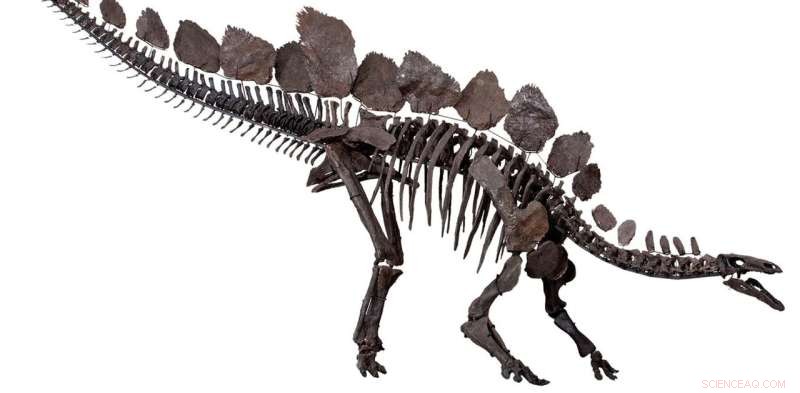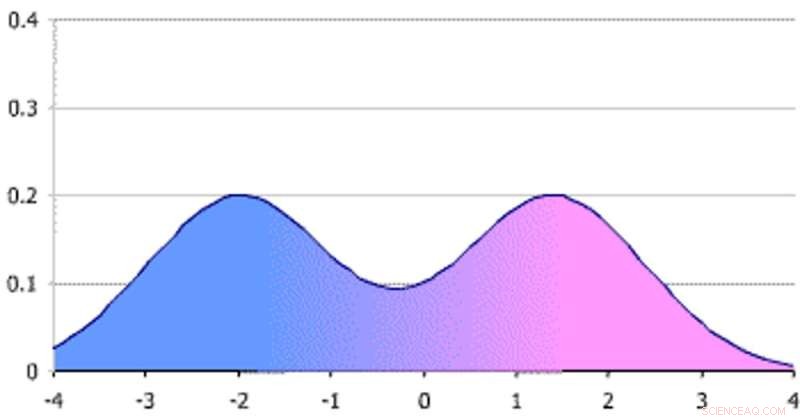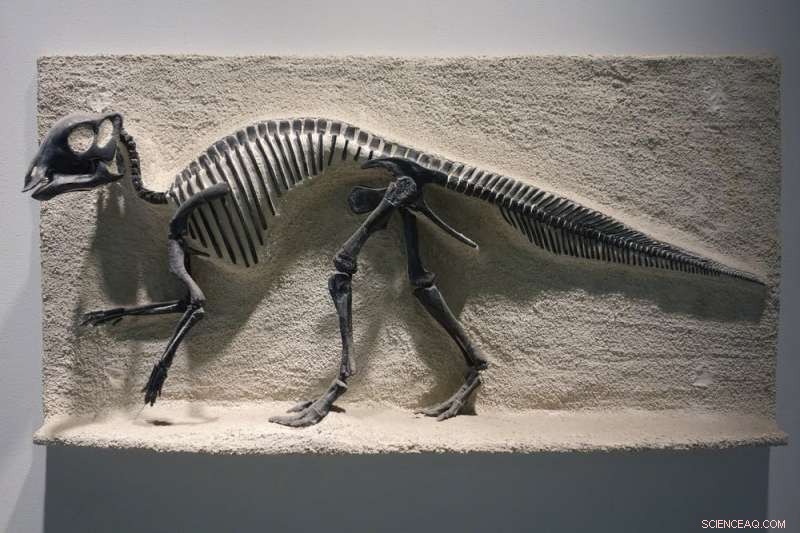
Comment les chercheurs peuvent-ils savoir si les dinosaures mâles et femelles, comme le stégosaure, sont différents ? Crédit :Susannah Maidment et al. &Natural History Museum, Londres, CC BY
Chez la plupart des espèces animales, les mâles et les femelles diffèrent. Cela est vrai pour les humains et les autres mammifères, ainsi que pour de nombreuses espèces d'oiseaux, de poissons et de reptiles. Mais qu'en est-il des dinosaures ? En 2015, j'ai proposé que la variation trouvée dans les plaques arrière emblématiques des dinosaures stégosaures était due aux différences de sexe.
J'ai été surpris de voir à quel point certains de mes collègues étaient en désaccord, affirmant que les différences entre les sexes, appelées dimorphisme sexuel, n'existaient pas chez les dinosaures.
Je suis paléontologue et le débat suscité par mon article de 2015 m'a fait reconsidérer la façon dont les chercheurs qui étudient les animaux anciens utilisent les statistiques.
Les archives fossiles limitées rendent difficile de déclarer si un dinosaure était sexuellement dimorphe. Mais moi et d'autres dans mon domaine commençons à nous éloigner de la pensée statistique traditionnelle en noir ou blanc qui repose sur les valeurs p et la signification statistique pour définir une véritable découverte. Au lieu de chercher uniquement des réponses par oui ou par non, nous commençons à considérer l'ampleur estimée de la variation sexuelle chez une espèce, le degré d'incertitude de cette estimation et comment ces mesures se comparent à d'autres espèces. Cette approche offre une analyse plus nuancée des questions difficiles de la paléontologie ainsi que de nombreux autres domaines scientifiques.
Différences entre hommes et femmes
Le dimorphisme sexuel se produit lorsque les mâles et les femelles d'une certaine espèce diffèrent en moyenne par un trait particulier, sans compter leur anatomie reproductive. Des exemples classiques sont la façon dont les cerfs mâles ont des bois et les paons mâles ont des plumes de queue flashy, tandis que les femelles n'ont pas ces traits.
Le dimorphisme peut aussi être subtil et sans éclat. Souvent, la différence est de degré, comme les différences de taille corporelle moyenne entre les mâles et les femelles, comme chez les gorilles. Dans ces cas modestes, les chercheurs utilisent des statistiques pour déterminer si un trait diffère en moyenne entre les hommes et les femmes.

Chez de nombreuses espèces, comme ces canards mandarins, les mâles (à gauche) et les femelles (à droite) sont très différents. Crédit :Francis C. Franklin via WikimediaCommons, CC BY-SA
Le dilemme des dinosaures
L'étude du dimorphisme sexuel chez les animaux disparus est pleine d'incertitudes. Si vous et moi déterrons indépendamment des fossiles similaires de la même espèce, ils seront inévitablement légèrement différents. Ces différences pourraient être dues au sexe, mais elles pourraient aussi être dues à l'âge - les jeunes oiseaux sont flous, les oiseaux adultes sont élégants. Ils pourraient également être dus à des facteurs génétiques sans rapport avec le sexe, comme la couleur des yeux chez l'homme.
If paleontologists had thousands of fossils to study of every species, the many sources of biological variation wouldn't matter as much. Unfortunately, the ravages of time have left the fossil record painfully incomplete, often with less than a dozen good specimens for large, extinct vertebrate species. Additionally, there is currently no way to identify the sex of an individual fossil except in rare cases where obvious clues exist, like eggs preserved within the body cavity.
So where does all this leave the debate on whether male and female dinosaurs had differences within traits? On the one hand, birds—which are direct descendants of dinosaurs—commonly show sexual dimorphism. So do crocodilians, dinosaurs' next closest living relatives. Evolutionary theory also predicts that, since dinosaurs reproduced with sperm and egg, there would be a benefit to sexual dimorphism.
These things all suggest that dinosaurs likely were sexually dimorphic. But in science you need to be quantitative. The challenge is that there is little in the way of statistically significant analyses of the fossil record to support dimorphism.

It’s possible that variation among individual dinosaurs of the same species could be due to sexual dimorphism, but there are rarely good enough samples to assert so using traditional statistics. Credit:James Ormiston, CC BY-ND
Statistical shifts
There are a couple of ways paleontologists could test for sexual dimorphism. They could look to see if there are statistically significant differences between fossils from presumed males and females, but there are very few specimens where researchers know the sex. Another method is to see whether there are two distinct groupings of a trait, called a bimodal distribution, which could suggest a difference between males and females.
To tell whether a perceived difference between two groups is true, scientists have traditionally used a tool called the p-value. P-values quantify the probability of a result being due to random chance. If a p-value is low enough, the result is deemed "statistically significant" and considered unlikely to have happened by chance.
But p-values can be heavily influenced by sample size and the design of the study, in addition to the actual degree of sexual dimorphism. Because of the very small sample size of fossils, relying on this statistical technique makes it exceedingly difficult to categorically proclaim what dinosaur species were dimorphic.
The weakness of the black-or-white approach that focuses solely on whether a result is statistically significant has led to hundreds of scientists calling to abandon significance testing with p-values in favor of something called effect size statistics. Using this approach, researchers would simply report the measured difference between two groups and the uncertainty in that measurement.

Very large sex differences can create a bimodal distribution that looks like two distinct groupings of a certain measurement. Credit:Maksim via WikimediaCommons, CC BY
Effect size statistics
I have begun to apply effect size statistics in my research on dinosaurs. My colleagues and I compared sexual dimorphism in body size between three different dinosaurs:the duck-billed Maiasaura, Tyrannosaurus rex and Psittacosaurus, a small relative of Triceratops. None of these species would be expected to show statistically significant size differences between males and females according to p-values. But that approach does not capture the nature of the variation within these species.
When we instead used effect size statistics, we were able to estimate that male and female Maiasaura demonstrate a greater difference in body mass compared to the other two species and that we had a higher confidence in this estimate as well. A few of the characteristics within the data helped reduce the uncertainty. First, we had a large number of Maiasaura fossils, from individuals of various ages. These bones very nicely fit with trajectories of how size changes as an individual grows from juvenile to adult, so we could control for differences due to age and instead focus on differences due to sex.
Additionally, the Maiasaura fossils all come from a single bone bed of individuals that died in the same place at the same time. This means that variation between individuals is likely not due to them being different species from different regions or time periods.
If my colleagues and I had approached the problem expecting a yes or no answer on whether males and females differed in size, we would have completely missed all of these intricacies. Effect size statistics allow researchers to produce much more nuanced and, I think, informative results. It is almost as much a difference in the philosophical approach to science as it is a mathematical one.

Using effect size statistics, researchers were able to determine that the duck-billed dinosaur Maiasaura showed a larger amount of dimorphism with the least uncertainty in that estimate compared to other dinosaurs. Credit:Daderot via WikimediaCommons
Studying dinosaur dimorphism is not the only place p-values create issues. Many fields of science, including medicine and psychology, are having similar debates about issues in statistics and a worrying problem of unrepeatable studies.
Embracing uncertainty in data—rather than looking for black-or-white answers to questions like whether male and female dinosaurs were sexually dimorphic—can help elucidate dinosaur biology. But this shift in thinking may be felt far and wide across the sciences. A careful consideration of problems within statistics could have deep impacts across many fields.